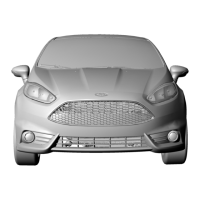What to do if I lost a key for my Ford Automobile?
- MmichealkelleyJul 26, 2025
If you've lost a key for your Ford Automobile, you can program a spare key or transmitter, or purchase a new one.

What to do if I lost a key for my Ford Automobile?
If you've lost a key for your Ford Automobile, you can program a spare key or transmitter, or purchase a new one.
What to do if I lost the only admin key for my Ford Automobile?
If you lost the only admin key for your Ford Automobile, purchase a new key or transmitter from an authorized dealer, or program a spare key or transmitter.
Why I cannot create a MyKey on my Ford 2015 Fiesta?
You might not be able to create a MyKey on your Ford Automobile because the key or transmitter used to start the vehicle does not have admin privileges, or it is the only admin key. For vehicles with keyless start, the transmitter may not be in the correct position. Also, the SecuriLock passive anti-theft system could be disabled or in unlimited mode.
Why I cannot program the configurable settings on my Ford Automobile?
You may not be able to program the configurable settings on your Ford Automobile because the key or transmitter used to start the vehicle does not have admin privileges.
Why no MyKey functions with the keyless start transmitter in my Ford Automobile?
If no MyKey functions are working with the keyless start transmitter in your Ford Automobile, it could be because an admin key or transmitter is present at engine start-up, or because no MyKeys are programmed to the vehicle.
Why MyKey distances do not accumulate on my Ford 2015 Fiesta?
MyKey distances may not accumulate on your Ford Automobile if the MyKey user is not using a MyKey, or if an admin key holder cleared the MyKeys and reset the key system.
| Brand | Ford |
|---|---|
| Model | 2015 Fiesta |
| Category | Automobile |
| Language | English |
Covers essential principles for using safety restraints for children.
Provides step-by-step instructions for installing child safety seats correctly.
Explains the LATCH system for child seat installation and its anchor points.
Provides instructions on how to correctly fasten lap and shoulder safety belts.
Describes how to properly adjust the shoulder belt height for effective safety.
Explains the driver and front passenger airbag system components and deployment.
Provides critical safety information regarding children and airbags to prevent injury.
Describes the system that detects occupants to enable or disable the front passenger airbag.
Explains the function of the integrated keyhead transmitter as a remote control.
Details the intelligent access key system for operating locks and starting the vehicle.
Provides instructions on how to create a MyKey for restricted driving modes.
Details how to lock and unlock the vehicle doors using the remote control and interior controls.
Explains various remote control functions for locking and unlocking doors.
Covers general information and operation of the keyless entry system.
Describes the engine immobilization system for vehicle security.
Details the perimeter alarm system for unauthorized access protection.
Provides instructions on how to adjust the steering wheel for optimal driving position.
Explains the operation of windshield wipers, including intermittent and speed-dependent modes.
Explains the different lighting control positions and their functions.
Explains the operation of power windows, including one-touch and bounce-back features.
Describes the tachometer, speedometer, fuel gauge, and coolant temperature gauge.
Explains the meaning of various warning lamps and indicators on the instrument cluster.
Explains various features of the SYNC system, including phone, navigation, and audio.
Explains how to interpret various status indicators and messages displayed by the vehicle.
Explains the controls and functions of the manual climate control system.
Describes the operation and features of the automatic climate control system.
Provides guidance on achieving a safe and correct driving posture.
Explains the importance and adjustment of head restraints for neck injury prevention.
Describes the function and usage of the 12V power outlet.
Details the procedures for starting the engine with manual and automatic transmissions.
Explains how to safely switch off the engine, including considerations for turbocharged engines.
Outlines critical safety warnings related to handling automotive fuel and refueling.
Covers recommended fuel types, octane ratings, and refueling procedures.
Details the electronic stability program and its function in maintaining vehicle stability.
Provides critical information on vehicle loading, weight ratings, and payload capacity.
Explains the complimentary roadside assistance program for Ford owners in the US and Canada.
Provides detailed instructions on safely jump starting a vehicle with jumper cables.
Guides on how to safely replace a blown fuse with the correct amperage rating.
Details procedures for checking and adding engine oil and coolant.
Explains how to use voice commands to control the SYNC system.
Details pairing phones, making/receiving calls, and managing phone features via SYNC.











